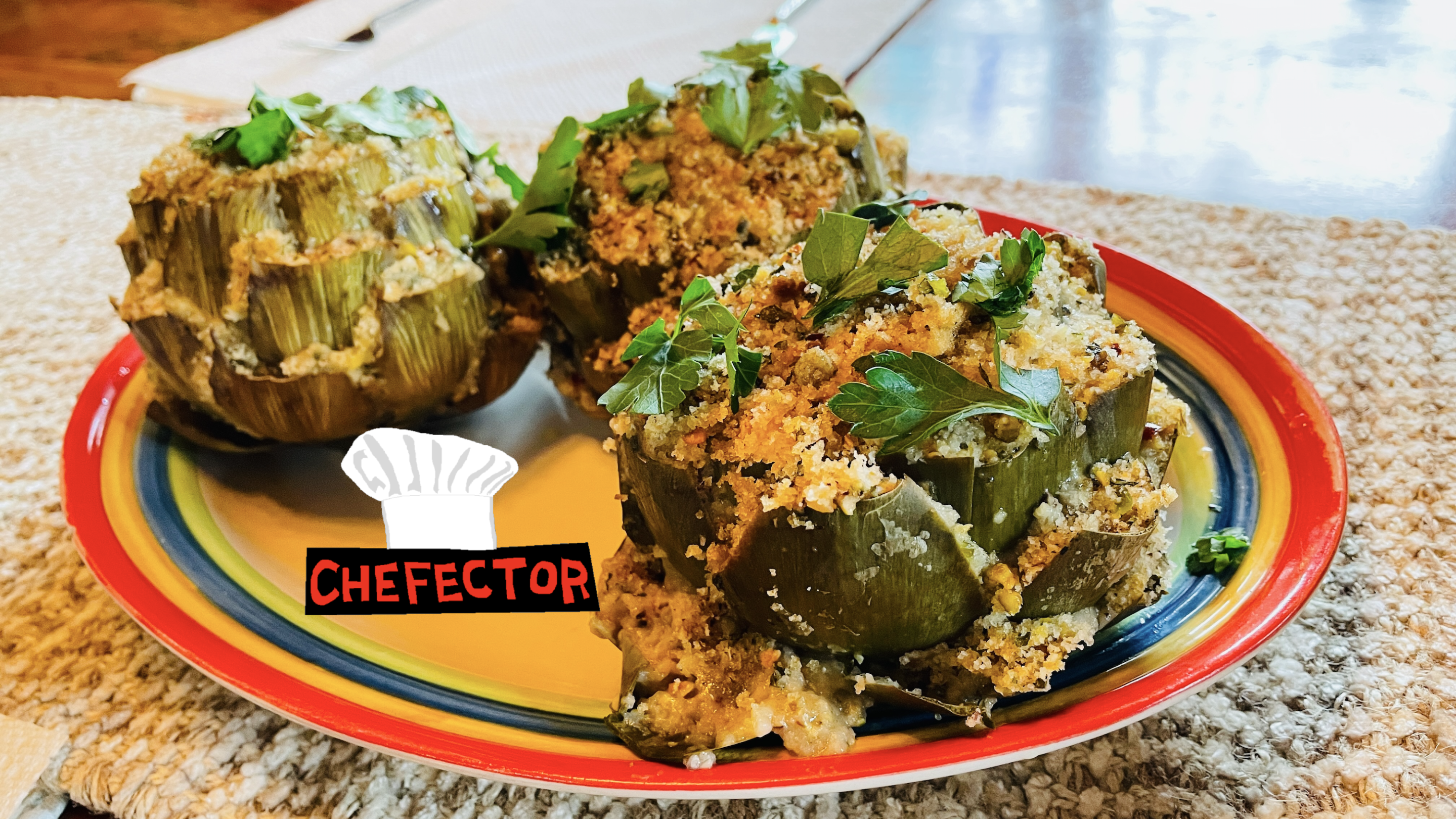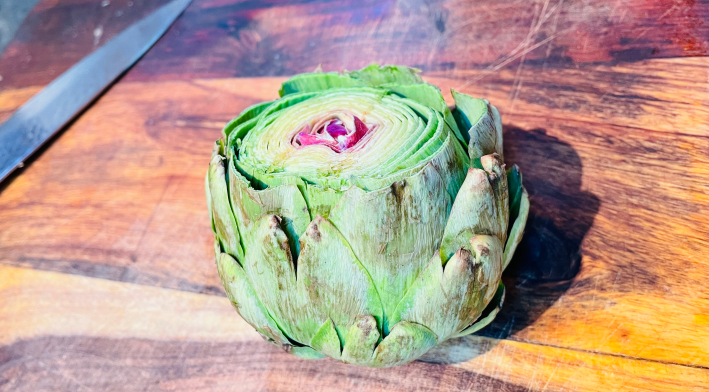Let’s Stuff Some Artichokes
10:02 AM EDT on March 19, 2022

Don't be fooled by the sudden abundance of produce at the supermarket. Everybody wants fresh food in spring, food to match the warmer weather and the sense that the world is returning to life, that the dark and miserable season of privation, or at least eating lots of brown food cooked in the oven, is over. It makes sense! But also nothing much is actually in season in March; the implication of the world only now beginning its return to greenness is that all of that freshly green stuff will not be ready for eating until, like, September.
The exception to this, or anyway one of them, is the artichoke, in season in spring and then again in the back half of the year. Artichokes are good right now! Good harbingers of springtime, and also good to eat. Trucked across the world, yes, sure, with terrible implications, yes, but everything has terrible implications in 2022; 2022 has terrible implications. Let's stuff some artichokes.
It's time-consuming and labor-intensive and pretty annoying, but then the result is delicious. Also, a corollary of treating stuffed artichokes as a rite of spring is that, over time, their association with the happy return of life to the world might make the tedium of their preparation itself seem sort of celebratory and fun. Or else you can simply decide never to do it again. But at least this once, let's do it.
Here are some things that you will need.
You will need some artichokes. Stuffing these suckers is tedious as hell, so I do not think you should go for more than one artichoke per person, if that, especially if they are nice big artichokes. That is to say, when you are selecting artichokes, go for the nice big ones. It's fine if their outer leaves are ugly; only the bit of each petal down by the core is actually edible.
If your artichokes have long stems, trim these down to, oh, maybe half an inch, nice and flat. Also, hack off the top half-inch to inch of each artichoke with your big knife, like so:

Also, with a pair of scissors, work your way around the outside of each artichoke, snipping off the tip of each petal, with the exception of any tiny outermost ones down by the base, which can be discarded or ignored. I took the above photo before doing that. You will just have to trust that I did, in fact, do it.
Do not worry that you are wasting precious 'choke, here. As we discussed a couple of sentences ago, the prickly top part of the leaves is not edible. What you're doing is making the artichoke easier to stuff.
Artichoke leaves turn brown quickly once they're cut. You can avert this somewhat by soaking them in cold water with some lemon juice in it for up to an hour, or by rubbing a lemon all over the cut edges of the leaves. Alternatively you can not care all that much about that.
You will need some breadcrumbs. Just regular breadcrumbs will do better than the larger panko, here. Stuffing the artichokes might get messy, and some of the stuffing is bound to go astray; to be on the safe side, let's say a third of a cup of breadcrumbs per artichoke. You'll need some cloves of garlic, one for every two artichokes, which you must mince finely, and some grated pecorino cheese, maybe half as much as the volume of breadcrumbs. You'll need a lemon or two, for squeezing. You'll need, oh, maybe just a teaspoon of dried oregano for every, uh, three artichokes. I'm spitballing, here.
You'll need a handful of leaves from some fresh tender herbs. Italian parsley is great for this; mint is a bolder choice but very good; any basil you can find this time of year is not to be trusted, unless you are reading this blog in the future and it's July now, in which case the artichokes are not to be trusted; possibly in September both the basil and the artichokes can be trusted at the same time. Cilantro and dill are lovely herbs in a general sort of way and I consider them great friends of mine, but I do not recommend them for this. I have never tried tarragon in a stuffed pepper. I guess I am recommending parsley or mint or both. Mince whatever you're using. Let's move on.
I strongly recommend including some crushed or otherwise ensmalled nuts in your artichoke stuffing. These can be pine nuts that you toast in a pan, then cool, and then crush or food-process into smaller pieces. If pine nuts are too pricy or too hard to find, your nuts can be roasted pistachios of the type you can find in most supermarkets, likewise crushed or food processed. (Hopefully I do not have to tell you to remove their shells in that case.) Toasted walnuts would also be lovely. Crushed or mortared or whatever.
I also recommend some nonpareil capers, the kind that come in a jar, but I recognize that this may be a losing battle if you are the sort of person who already blanched at the mint. If you're using the capers, give them a quick chop with your big knife or a couple pulses in the food processor to make them smaller and more manageable. You'll need salt, naturally, and probably freshly ground black pepper, and some red pepper flakes would not go unwelcome in your artichoke stuffing. You will also need some extra-virgin olive oil.
I think that's it for the edible stuff. Now I'm going to digress for a minute.
As I've mentioned a couple of times, stuffing artichokes is a pain in the butt. On the other hand, the stuffing ingredients up there are going to yield something very tasty that can be used to sexify other delicious plantlife: bell or sweet Italian peppers, baby or full-size zucchini, big huge summer tomatoes, eggplant, broccolini, you get the idea.
A really great thing you can do, if you simply do not want to stuff artichokes with the above ingredients, is to cook the garlic and the chili flakes in some glugs of the oil until they're fragrant, and toss in the breadcrumbs until they've absorbed the oil and toasted up a little bit. Then, let that mixture sit in a bowl for a little while until it has cooled, and toss in the grated cheese, the herbs, the capers, the salt and pepper, and play around with using this stuff to dress up vegetables that you seared a hot pan (or blanched and shocked, and then roasting them in the oven. I like to do this with halved peppers. It's divine. Thank you for indulging this tangent.
For equipment, a big deep pot with a heavy, tight-fitting lid will be grand. If you have one of those lil' steamer tray guys that looks like a flying saucer and opens like a flower, that'll be great, especially if opens as wide as the diameter of that pot, but you can get along without it. You'll need a real big bowl, for mixing the ingredients that will stuff the artichokes. A pair of tongs will help you to maneuver the cooked artichokes later on without scalding your hands. When you get around to eating the artichokes, you'll have use for a sharp knife smaller and more maneuverable than your huge chef's knife. Maybe a steak knife? You'll need a regular spoon, for scooping the stuffing into the leaves of your artichokes. I think that's everything.
OK! So! From here it gets very easy. As a writing project. As a cooking endeavor it is in fact quite annoying.
Fill the bottom of the big pot with, oh, somewhere in the neighborhood of an inch of cold salted water. If you have the little steamer tray guy, put the little steamer tray guy in there. Also, put the pot on the stove, so that you will not have to move it later on when it has a bunch of stuffed artichokes balanced precariously inside it.
In that big bowl from two paragraphs ago, dump the breadcrumbs, the cheese, the minced garlic, all of the oregano and most of the fresh herbs, the crushed nuts, the capers, and as many varieties of pepper as you decided to use. Mix all of this together with your hands or a spoon or the blade of whichever of the alarming swords displayed about your home seems cleanest. Taste the mixture you have made. Does it need salt? Then add some salt. Could it use some more black pepper? Go for it. Are you tempted to just eat this stuff with a spoon? Me too.
Now comes the part that sucks! I'm not going to boldface any of it! I'm just going to say stuff the artichokes, and leave the following two paragraphs for helping you do that.
OK, so, you have your lil' spoon. What you're gonna do is, you're gonna scoop a little bit of the stuffing, and you're gonna have this little scoop of stuffing in the spoon in one hand. With the other hand, you're gonna gently pull an artichoke petal back to open up some of the space between it and its fellows, and you're gonna gently scoop that little scoop of stuffing in there. Some of it might spill! That's OK. You only have to do it a trillion more times.
It's not important for you to, like, abundantly stuff every petal on the artichoke. At a certain point, as the leaves get smaller and thinner toward the center, it's going to be more like you are just scooping the stuffing over the top of the thing and trusting that it will work its way down between the leaves, and that's basically true. Still. This is tedious. I am very sorry.
When each artichoke is stuffed, it will look like it has a cute lil' mound of stuffing on top. That is the end of the part that sucks. Now I will resume boldfacing. Drizzle some of the olive oil over each artichoke when you finish stuffing it, and line the artichokes up in the pot so that they are standing up, presenting their stuffing to the sky. It's fine to lean them against each other or the side of the pot or, what the hell, a strategically placed coffee mug, to achieve this. What's important is that they not be allowed to tip over and spill their stuffing all over the place, and that if they do, it is not my fault but yours.
Turn the heat on under the pot and clap the lid on there. In a few minutes the water will have come to a boil. Set a timer for 45 minutes and leave the pot alone. If the lid is nice and tight on there and does not have one of those holes to allow steam to escape, the water in there will suffice to steam them for that entire time. Otherwise you might consider checking after 20 minutes to make sure there's still water in there.
Nothing in the artichoke stuffing particularly needs to cook; what you're waiting for is for the artichokes themselves to cook. You can tell they've done this by plucking off one of the big outer leaves. If it comes off with a gentle pull, the artichoke is done; if it offers more than bare minimal resistance, cook the artichokes for another 10 minutes and try again. At that point if they are not done it is time to make sure that you remembered to turn the stove on. Squeeze some lemon juice over the cooked artichokes, and drizzle a little more olive oil on them, and scatter the remaining minced herbs over them also. Now you can eat them. About that.
It's maybe not intuitively clear how to do this. Pluck a petal off. Hold it by the fibrous outer end. Insert the other end into your mouth, close your teeth gently, and pull; the stuffing will come off as you go, and then when you reach the edible part of the petal, you can bite that off and enjoy it with the lil' bite of stuffing you got. Mmmm.
The outer leaves will have a thick nub of edible artichoke down at the bottom; the inner leaves will not have the big nubs, but more of the length of each inner petal will be tender and not like trying to bite through the skin of a pineapple. Some of the innermost leaves will be pretty much all edible, except for their tips.
Eventually you will come to the innermost part of the choke, the part that I can't help but use the word "furry" to describe. Think of the artichoke like a flower, because that's more or less what it is. This is the part of it that would have bloomed and spread, eventually, and presumably produced baby artichokes. It's not for eating, unless you particularly want a mouthful of inedible fur. With that little knife I mentioned 54 million words ago, cut this off of the base of the artichoke; trim around the vaguely funnel-shaped top of the artichoke heart to cut away all of the fur. Also with that knife, trim away any fibrous stem remaining at the bottom. What's left is the artichoke heart, a nice big satisfying hunk of delicious food. A real prize! Eat it. Cut it in half and share it with someone.
A year from now, or maybe 10, the tedium of stuffing artichokes will have faded somewhat. Spring will arrive, and you will see artichokes at the supermarket or produce stand, and maybe you will think how nice it would be to plow through a stuffed artichoke—to share one, even! Maybe you will think about what a good time it is to share the kind of food you eat with your hands out in the sunshine. The appeal of this will seem realer and more vivid than the chore of making stuffed artichokes. Maybe it will crystallize into an idea. It's a good one. I recommend acting on it.
If you liked this blog, please share it! Your referrals help Defector reach new readers, and those new readers always get a few free blogs before encountering our paywall.
Assignment Editor
Stay in touch
Sign up for our free newsletter




